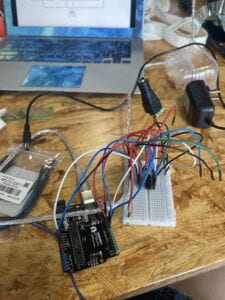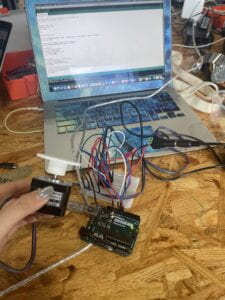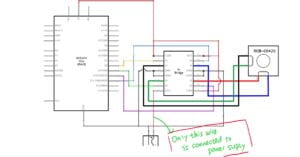This week’s recitation is very intriguing. We have to construct a sketching machine! It’s intriguing to me because it makes art through a machine rather than through people, which prompts the question of whether the crawl generated by the machine is art or not.
The circuit appeared difficult at first, but after it was obvious that all of the grey lines were linked to ground and virtually all of the red lines were connected to 5V, everything fell into place. However, I made a critical error that almost resulted in the death of my Arduino. I connected all of the red lines to the single Arduino red line, then to both 5V and the power supply, which was a mistake. Step 1 was completed successfully, and step 2 was completed successfully until the motor failed in step 3.
Code:
/*
MotorKnob
A stepper motor follows the turns of a potentiometer
(or other sensor) on analog input 0.
http://www.arduino.cc/en/Reference/Stepper
This example code is in the public domain.
*/
#include <Stepper.h>
// change this to the number of steps on your motor
#define STEPS 200
// create an instance of the stepper class, specifying
// the number of steps of the motor and the pins it’s
// attached to
Stepper stepper(STEPS, 8, 9, 10, 11);
// the previous reading from the analog input
int previous = 0;
void setup() {
// set the speed of the motor to 30 RPMs
stepper.setSpeed(30);
}
void loop() {
// get the sensor value
int val = analogRead(0);
// move a number of steps equal to the change in the
// sensor reading
val = map(val, 0, 1023, 0, 200);
stepper.step(val – previous);
// remember the previous value of the sensor
previous = val;
}
Question 1: What kind of machines would you be interested in building? Add a reflection about the use of actuators, the digital manipulation of art, and the creative process to your blog post.
After reading ART+Science NOW, I would like to build machines that involve the interaction between humans and the LED lights. I want to create something for hearing disability people. It will be a setting that can reflect peoples voice volume. The led will change colors according to the volume.
The actuator for this machine might be an sound sensor and an LED screen that fills with LEDs. To be more precise, there need to be many infrared distance sensors, which are used to detect people to make sure its the human that’s making sound.
The Arduino first needs to read what the sensors have detected, which indicates people’s voice. The changing values of some sensors indicate the volume of the voice. The output of the machine is the changes in LEDs lighting. Different people’s voice may influence the LEDs’lighting. The programming of controlling the lighting of the LEDs might be difficult and sophisticated.
I believe the creative process is mostly determined by how the LEDs will vary in response to the data collected by the sensor. It provides a lot of room for innovation. It may be used for commercial marketing or just for enjoyable engagement, for example. The application may be varied, and diverse creations can be filled with a variety of creativity.
Question 2: Choose an art installation mentioned in the reading ART + Science NOW, Stephen Wilson (Kinetics chapter). Post your thoughts about it and make a comparison with the work you did during this recitation. How do you think that the artist selected those specific actuators for his project?
Louis-Philippe Demers and Garry Stewart, Devolution, 2006
This interactive work of art portrays robots as equals to human dancers, as well as demonstrating how human actions affect robot behavior in the context of “ecosystem dynamics.” The connection between humans and robots is similar to what we’ve seen with our sketching machine. However, in our recitation, we viewed our computer as a tool rather than a human being. The actuators in the project demonstrated the beauty of machinery’s rhythm when performing dance. In other words, their erratic mechanical movement contrasted with human dancers’ graceful movement.


